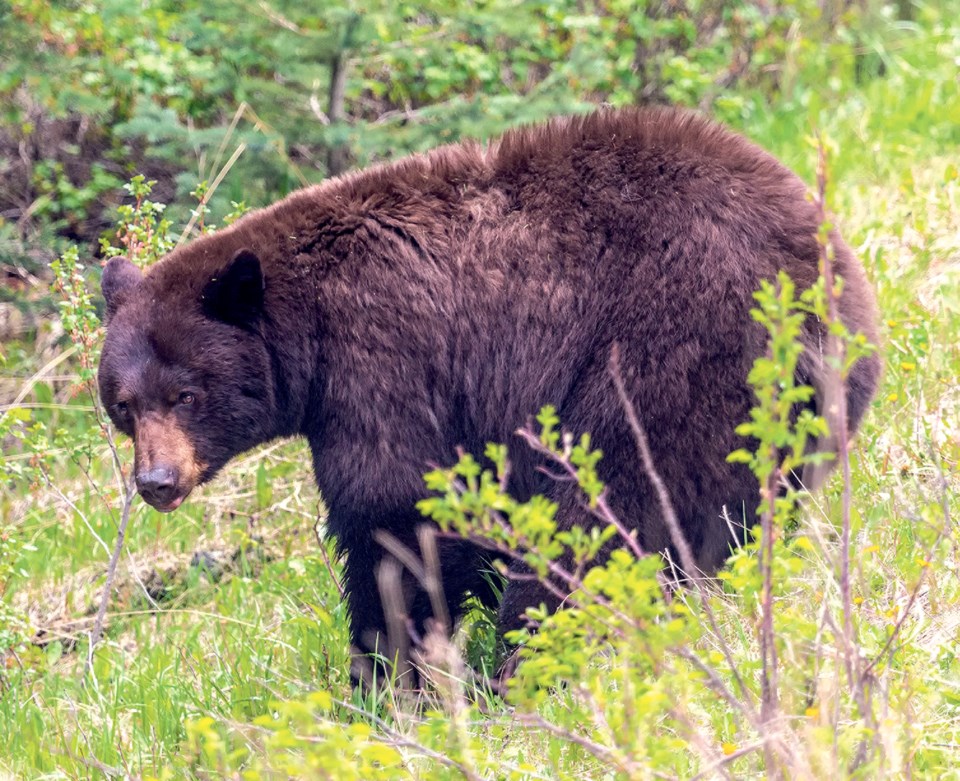BANFF – An injured adult male black bear perhaps hit by a train or vehicle near the Banff townsite has been captured and collared so wildlife experts can track his movements and keep a closer eye on him.
Parks Canada got word of an injured bear in late May that had been hanging around Compound Meadows and Rocky Mountain Resort, but the bruin wasn’t immediately found despite an extensive search.
Kira Tryon, a spokesperson for Banff National Park, said the bear has been located since then and was seen having trouble bearing weight on its back left leg.
“A wildlife veterinarian assessed the bear remotely and found it to be moving well, feeding normally, and appearing otherwise healthy,” she said in an email statement.
“The bear responded well to light hazing, so no further action was necessary.”
In the following weeks, the bear moved towards higher human-use areas east of Compound Road.
Because it was hanging out in a busy area in and near Banff’s industrial compound, wildlife experts captured the bear on June 16.
“A complete health assessment revealed that the young adult male had a broken left rear leg in a moderate to advanced stage of healing,” said Tryon.
“There were no infections or open wounds, and it did not require additional intervention at the time.”
With the bear healing and otherwise healthy, it was fitted with a GPS collar so wildlife officers could monitor it.
Parks isn’t saying if the bear got into any food or garbage, or had any close encounters with people.
Tryon said any future management actions, if required, will be based on the bear’s health and behaviour.
“The bear is seemingly doing well and is responsive to Parks Canada’s hazing efforts to keep it away from human-use areas,” she said.
Parks Canada does not typically intervene with natural wildlife injuries, but Tryon said incidents are evaluated on a case-by-case basis, taking into consideration human safety and animal welfare.
“Bears have a remarkable ability to heal and live normal lives without conflict with humans, even with three functional legs,” she said.
Colleen Campbell, a long-time local bear researcher and member of Bow Valley Naturalists’ board of directors, said she is pleased to hear this injured black bear is being given a chance to survive.
“We know animals heal, and go about their lives, sometimes for a long, long time,” she said.
But Campbell’s fear is tourists will feed the injured bear, which starts down the dangerous path towards habituation and food-conditioning, and more often than not, results in the death of the bear.
“If anyone sees a bear limping they will probably give it food. People sometimes reposed to injured animals with their heart and not all their wisdom – and that would be a big problem,” she said.
Campbell is happy to hear the bear is being tracked with a GPS collar so it can be hazed away if it does come back near roads or busy human-use areas.
“If we want to keep want it alive, we have to put in every effort,” she said.
Black bear numbers in Banff National Park are estimated to be between 20 and 40, according to Parks Canada’s website.
There are estimated to be 90 in Jasper National Park, 20 to 50 in Yoho National Park and 30 to 50 in Kootenay National Park.
Habitat fragmentation, habituation, and road and railway strikes take their toll on the black bear population in the mountain parks.
Though black bears are more common than threatened grizzly bears in Alberta, Campbell said they deserve just as much respect.
“Even though we think of grizzlies as this uber umbrella species, black bears still have a huge interaction with the environment and a great deal to do with the health of the habitat they live in,” she said.
“They produce a little more quickly than brown bears do in this area and so their numbers bounce back a little bit more from the numbers we’ve killed on the rail and highway. We’ve killed away more than brown bears.”
Despite repeated requests for an interview with wildlife resource conservation officers since the black bear was injured in late May, and again after the bear was collared, Parks Canada did not grant the Outlook an interview.
The agency said a written response was deemed most appropriate because this is an extremely busy time of year and this is a standard operational issue.
Meanwhile, Parks Canada reminds visitors and residents to be alert and show wildlife respect while recreating in Banff National Park.
“This includes carrying bear spray and knowing how to use it, making noise on trails, keeping dogs on leash or leaving them at home, and travelling in groups,” said Tryon.
Detailed wildlife safety information is available from the Visitor Information Centre, or by visiting the Banff National Park website at www.pc.gc.ca/banff-wildlife.



